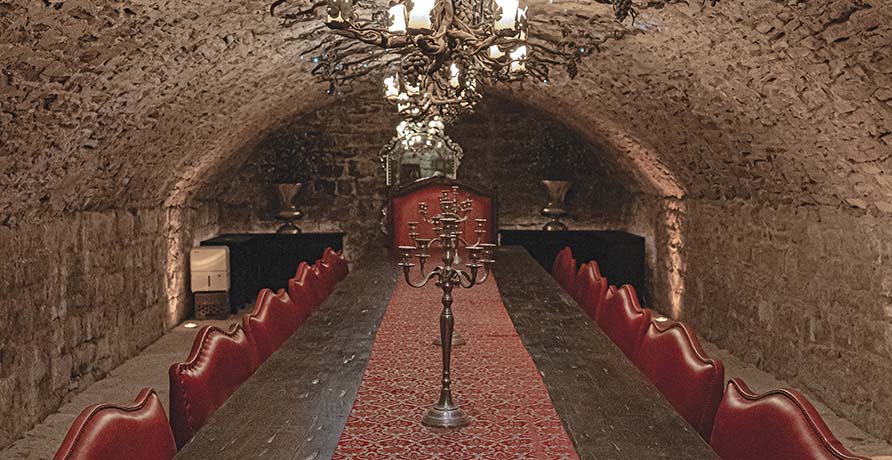2022 Best of Lake Erie: History
Blast into the past with a trip to one of these Lake Erie historical sites.

Tour: Vin Villa: The Pompeii of Pelee Island
The stone skeleton of the Vin Villa Winery lay in ruins just beyond a locked metal gate on Pelee Island’s north shore, but what lies beneath the surface would make Bacchus, the god of wine and pleasure, extremely proud. There, a team of investors has turned one of the underground wine cellars of Canada’s first commercial winery into a den of decadence rivaling some of the best wine cellars in the world. The price for a dinner party for 28 guests starts around $200 per person, but the space is rumored to have hosted a $64,000 meal for 10 people.
Double wrought-iron doors adorned with working torches and knobs in the shape of Vs lead to the long windowless cellar with an arched ceiling. A long antique wooden table with red-leather chairs runs the length of the space, but the most impressive detail is a 48-foot-long chandelier with metal grape vines creeping across the hand-hewn stone ceiling. Hidden among the iron branches are 50 LED lights, not to mention some of Pelee Island’s rare and endangered animals, such as the blind salamander and blue racer snake.
Take a tour of the ruins with Pelee Island Adventures, the most affordable way to go beyond the gate. The one-hour walking tour includes a tasting of Pelee Island Wine in the Vin Villa cellar, a visit to the island’s legendary Hulda’s Rock and a primer on why Vin Vill is one of the most historically significant viticultural sites in North America. Guests also walk away with a limited-edition replica of the bronze medallion the winery won at the 1878 World’s Fair in Paris.
“In the 1800s, the Europeans snubbed their noses at new-world wines,” explains Clayton Walls, owner of Pelee Island Adventures, “but the win at the World’s Fair put North American wine on the map.”
Pelee Island, Ontario, 226-724-4742, peleeislandadventures.com
Battlefield Park: River Raisin National Battlefield Park
As a native of Monroe, Michigan, Jami Keegan didn’t hear much about the battles at River Raisin during the War of 1812 — in no small part because they resulted in severe losses for the U.S., with more than 900 of a force of a thousand either killed, wounded or taken prisoner.
“There were a lot of horrendous things that happened,” says Keegan, now the chief of interpretation and education at the River Raisin National Battlefield Park, which opened in 2011.
The battle in what was then the western front of the war was a resounding victory for Native American forces that had allied with the British — and its effects have rippled to the present day. The slaughter of wounded Americans following surrender — estimates run anywhere from 10 to 100, with the truth likely somewhere in the middle — led to the enforcement of the Indian Removal Act throughout the rest of the 19th century.
“The battle was small in the scope of the War of 1812, but the impact is still being felt today,” Keegan says.
The River Raisin National Battlefield Park offers walking and biking trails, as well as the Visitor and Education Center, which includes a state-of-the-art theater where guests can view the park’s new film, The Untold Legacy of the River Raisin,” for free.
Monroe, Michigan, 734-243-7136, nps.gov/rira
Making Art Matter: Roger Tory Peterson Institute
It’s not hyperbole to say that Roger Tory Peterson was the father to modern field guides. Starting with his Guide to the Birds, published in 1934, Peterson wrote more than 20 books on nature, filled with colorful illustrations and photos, many done by him. “It can’t be overstated how important the field guides are,” says Arthur Pearson, director of the Roger Tory Peterson Institute, dedicated to being a living embodiment of his guides. The facility includes a 27-acre nature preserve as well as a lodge designed by Robert A.M. Stern reflecting Greek influences as well as the early 20th century Arts & Crafts movement.
The institute is home to more than 100,000 pieces, from artwork to illustrations, photos and movies — many of which were done by Peterson himself. The institute hosts three exhibits a year, not just of his work, but of established nature artists as well as those on the rise.
Jamestown, New York, 716-665-2473, rtpi.org
Renovation: The Aviator
For decades, the 100th Bomb Group was a destination for dinner and special events. But the restaurant closed in 2020, its World War II-era memorabilia disbursed and the planes donated to the MAPS Museum in Stark County.
Today, it’s the Aviator. Opened in April 2022, the facility still features a boutique restaurant and bar (executive chef Jon Standen worked with Michael Symon) but is leaning into being an events center, with a total of five rooms, from a room accommodating 30 people for smaller events to a banquet center that can hold up to 350. A rooftop bar is also planned — so revelers can watch planes take off and land from the Cleveland airport.
The restaurant had a World War II era theme, resembling a French chateau, but its look has been modernized. “We tried to keep the bones, but get a little more modern,” says President Khadar Soussou. And the former gift shop is now an events design center, with options for linens, china and other decorations, living up to the facility’s slogan of “imagination without barriers.”
Cleveland, Ohio, 216-770-5300, aviatorcle.com






